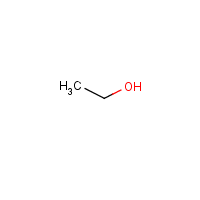Ethyl alcohol
Agent Name
Ethyl alcohol
Alternative Name
Ethanol
CAS Number
64-17-5
Formula
C2-H6-O
Major Category
Solvents

Synonyms
1-Hydroxyethane; Absolute ethanol; Aethanol [German]; Aethylalkohol [German]; Alcohol; Alcohol (ethyl alcohol); Alcohol dehydrated; Alcohol, anhydrous; Alcohol, diluted; Alcohol, ethyl; Alcohols; Alcool ethylique [French]; Alcool etilico [Italian]; Algrain; Alkohol [German]; Alkoholu etylowego [Polish]; Anhydrol; Cologne Spirit; Denatured alcohol; Denatured alcohol CD-10; Denatured alcohol CD-5; Denatured alcohol CD-5a; Denatured alcohol SD-1; Denatured alcohol SD-13a; Denatured alcohol SD-17; Denatured alcohol SD-23a; Denatured alcohol SD-28; Denatured alcohol SD-30; Denatured alcohol SD-39b; Denatured alcohol SD-39c; Denatured alcohol SD-3a; Denatured alcohol SD-40m; Denatured ethanol; EtOH; Etanolo [Italian]; Ethanol 200 proof; Ethanol [JAN]; Ethanol solution; Ethyl alcohol; Ethyl alcohol & water, 10%; Ethyl alcohol & water, 20%; Ethyl alcohol & water, 30%; Ethyl alcohol & water, 40%; Ethyl alcohol & water, 5%; Ethyl alcohol & water, 50%; Ethyl alcohol & water, 60%; Ethyl alcohol & water, 70%; Ethyl alcohol & water, 80%; Ethyl alcohol & water, 95%; Ethyl alcohol & water, 96%; Ethyl alcohol anhydrous; Ethyl alcohol usp; Ethyl hydrate; Ethyl hydroxide; Ethylalcohol [Dutch]; Etylowy alkohol [Polish]; Fermentation alcohol; Grain alcohol; Hydroxyethane; Jaysol S; Methylcarbinol; Molasses alcohol; Potato alcohol; SD Alchol 23-hydrogen; Spirits of wine; Tecsol; Tecsol C; [ChemIDplus] UN1987; UN1170
Category
Alcohols (<C12)
Description
Clear, colorless liquid with a weak, ethereal, vinous odor; [NIOSH]
Sources/Uses
"Clear, colorless liquid rapidly absorbed from the gastrointestinal tract and distributed throughout the body. It has bactericidal activity and is used often as a topical disinfectant. It is widely used as a solvent and preservative in pharmaceutical preparations as well as serving as the primary ingredient in ALCOHOLIC BEVERAGES." [ChemIDplus]
Comments
Drinking alcoholic beverages is a known human carcinogen listed by the International Agency for Research in Cancer (IARC) and the National Toxicology Program (NTP). "Alcohol consumption causes cancers of the oral cavity, pharynx, larynx, oesophagus, colorectum, liver (hepatocellular carcinoma) and female breast." [Reference #2] That ethyl alcohol is unlikely to be an occupational carcinogen is reflected by its classification as "5" by MAC. MAC defines "5" as, "Substances with carcinogenic and genotoxic effects, the potency of which is considered to be so low that, provided the MAK and BAT values are observed, no significant contribution to human cancer risk is to be expected." Drinking alcoholic beverages is also a reproductive hazard, causing fetal alcohol syndrome. Low level occupational exposures are not likely to harm the fetus. [Frazier, p. 175-7] Inhalation of high concentrations can cause CNS depression; An eye and respiratory tract irritant; [ICSC] Suspected germ cell mutagen (3B); [MAK] Causes non-immunological contact urticaria; [Kanerva, p. 219]
Reference Link #1
Biomedical References
Exposure Assessment
Skin Designation (ACGIH)
Insufficient data
STEL (ACGIH)
1000 ppm
PEL (OSHA)
1000 ppm
MAK
200 ppm
IDLH (NIOSH)
3300 ppm
Excerpts from Documentation for IDLHs
Human data: It was reported in a clinical study that concentrations greater than 20,900 ppm were intolerably irritating and 15,000 ppm caused continuous lacrimation and coughing while concentrations between 5,200 and 10,400 ppm allowed work to be carried on, but with a certain amount of discomfort [Lester and Greenberg 1951]. In this same study, it was determined that 62% of the ethyl alcohol inhaled was absorbed [Lester and Greenberg 1951].
Vapor Pressure
59.3 mm Hg
Odor Threshold Low
49 ppm
Odor Threshold High
716 ppm
RD50
27314 ppm
Lethal Concentration
LC50 (rat) = 20,000 ppm/10H
Explanatory Notes
IDLH = 10% LEL; Detection odor threshold from AIHA (mean = 180 ppm); Flash point = 55 deg F; VP from HSDB;
Reference Link #2
NFPA
may ignite at ambient temp
ERPG-1
1800 ppm
ERPG-2
3300 ppm
ERPG-3
Not appropriate
Adverse Effects
Neurotoxin
Acute solvent syndrome
Hepatotoxin
Hepatoxic (a) from occupational exposure (secondary effect) or (b) in animal studies or in humans after ingestion
Reproductive Toxin
Yes
ACGIH Carcinogen
Confirmed Animal
Diseases, Processes, and Activities Linked to This Agent
Diseases
Occupational diseases associated with exposure to this agent:
Processes
Industrial Processes with risk of exposure: